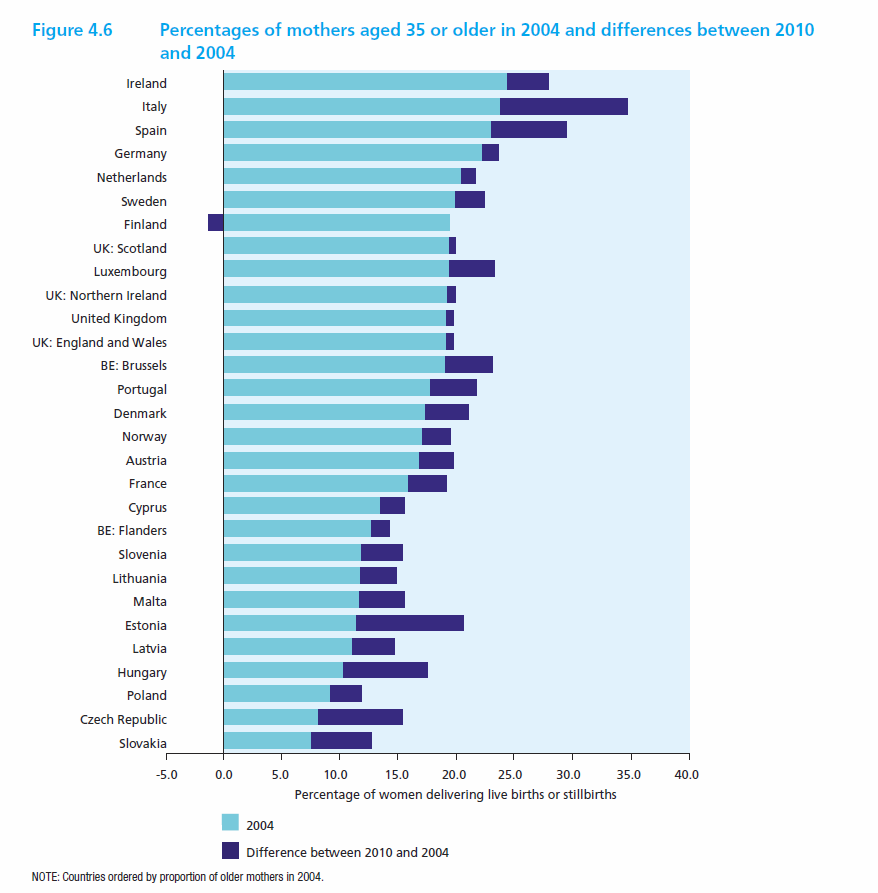INVITED COMMENTARIES: Advanced Maternal age in Europe 2004 vs. 2010

In France:
“Advanced maternal age is not a new trend: the age of women giving birth in France is 30 years old on average, the same as in the 19th century and at the beginning of the 20th century, but reasons behind late childbearing have changed drastically over time. A century ago, families were larger, women gave birth many times and they married late to limit births. Now, women stay in school longer, entry into the workforce is delayed, couples form stable households later, blended families are more common and effective family planning methods are more widespread.
Today, having a child often results from a well thought out decision. It is unfortunate that many women (and men) are not aware of the sharp decline in fertility after age 35 and the risks associated with advanced maternal age. Efforts are being made to alert women and their health care providers, but this message is hard to get across in France.”
- Dr. Béatrice Blondel
Dr. Béatrice Blondel is a perinatal epidemiologist at the French National Institute of Health and Medical Research (UMR1153) and scientific committee member from France
In Finland:
“Between 2004 and 2010 the proportion of mothers aged 35 years or older increased in all Euro-Peristat countries, with the exception of Finland. National statistics show that this proportion decreased from 19.4% to 17.8% between 2005 and 2009 and the trend was similar in urban and rural areas, and in most hospital districts.
Successful national-level social policy action may be one explanation. In 2003, Prime Minister Matti Vanhanen, from the Centre Party, called for measures to increase fertility and to promote early childbearing. The government increased the level of cash benefits for families, and maternity, paternity and parental leaves qualified for pension rights starting in 2005. Families welcoming a second child before the first-born’s third birthday are also eligible for increased allowances if the mother did not work in-between pregnancies.
There may be other reasons behind the Finnish exception. The migrant population has been increasing rapidly in Finland. In 1990, 0.3% of infants came from an “other than Finnish” background. This share increased to 3.4% in 2004 and to 9.4% in 2014. As in many other European countries, migrants from low and middle income countries initiate childbearing earlier than Finns. Nonetheless, recent trends seem to go against this “migrant hypothesis” - the share of mothers aged 35 years or older increased to an all-time high of 20.4% in 2014. Unfortunately, the Medical Birth Registry was denied the right to collect information on migrants’ background until February 2016 but more detailed data linkage analyses will be conducted on this topic before summer.”
- Prof. Mika Gissler
Prof. Mika Gissler is a perinatal epidemiologist at the National Institute for Health and Welfare (THL) and scientific committee member from Finland
In the Netherlands:
“This graph shows that the number of mothers 35 years or older increased over time. In countries with historically low numbers of pregnant women over 35, the increase is remarkable and stronger than in the majority of the other countries – except in Italy, Spain and Ireland where figures were already high in 2004 and increased still in 2010.
This increase is disturbing given the known risks associated with advanced maternal age. Health care providers usually mention the increased risks of chromosomal anomalies and preeclampsia during antenatal counseling but maternal age is also a strong independent variable for the risk of sudden intrauterine unexplained death (SIUD) without growth retardation. This has been shown in a Norwegian population-based study by Froen et al (Acta obstet Gynecol Scand 2004; 83: 801-807). The risk of SIUD increases with 16% each year and becomes significant at 35 years and older (adjusted odds ratio 4.2 [95% confidence interval 1.02-16.49]).
It would be good to confirm these results in other populations, but it is also another strong argument for having children at a younger age…work to be done!”
- Prof. Jan Nijhuis
Prof. Jan G. Nijhuis MD PhD is an obstetrician, head of the OB/GYN Dept. of the Maastricht University Medical Centre, and scientific committee member from The Netherlands. He is a former president of the Dutch Organization of Obstetrics and Gynaecology (NVOG). His main interest and research areas are foetal monitoring and ‘home delivery issues’, as well as perinatal audit.

